
Collection Final Demand Letters
The response you get from sending a collection final demand letter for payment to a delinquent customer determines your next step. A final demand letter lets your tardy customer know that you will no longer allow them to procrastinate on paying their bill, or account. The letter also informs them you intend to take further steps if they do not pay by a specific date. Basically, a final demand letter is a formal demand requesting payment in full.
When to Send a Final Demand Letter
Most companies send a final demand letter when an account, invoice or bill hits, or approaches a specific number of days outstanding. The specific number of days depends on your industry collection and credit terms. For most industries with 30 days terms, receivables are aged by 30-60-90-120 and 180 days. Keep in mind, a receivable is only worth 50% after 180 days. Here are the accounts receivable industry statistics on age and debt collection.
Many companies with 30 day terms send a final demand letter when an account is overdue by 60 or 90 days. Time is far more sensitive when dealing with commercial debtors, compared to individual consumer debtors. A wise policy is to set a trigger date when a debtor is automatically sent a final demand letter.
What a Final Demand Letter Should Contain
These are the salient points that should be in a final demand letter :
- Date of Letter
- Amount owing, Account number
- Deadline Date for Payment (usually 5 days)
- What steps you intend to make if they don???t pay
The bottom line is you have already been more than patient and it is time for them to pay their bill in full. The demand letter can be sent via email, regular mail, fax, or registered mail. As far as your next step should the debtor not pay, simply advise the debtor you intend to place their account with your lawyer or collection agency. Giving a debtor a 5 day deadline to pay creates a sense of urgency when the debtor reads your final demand letter.
Next Step if Debtor Doesn't Pay
The worst thing you can do is to continue communications with the debtor if they don't pay. Any further communication tells'the debtor you are not serious about your final demand. The best tactic is to place the account with a collection agency. It is always better to get X% of something than 100% of nothing.


